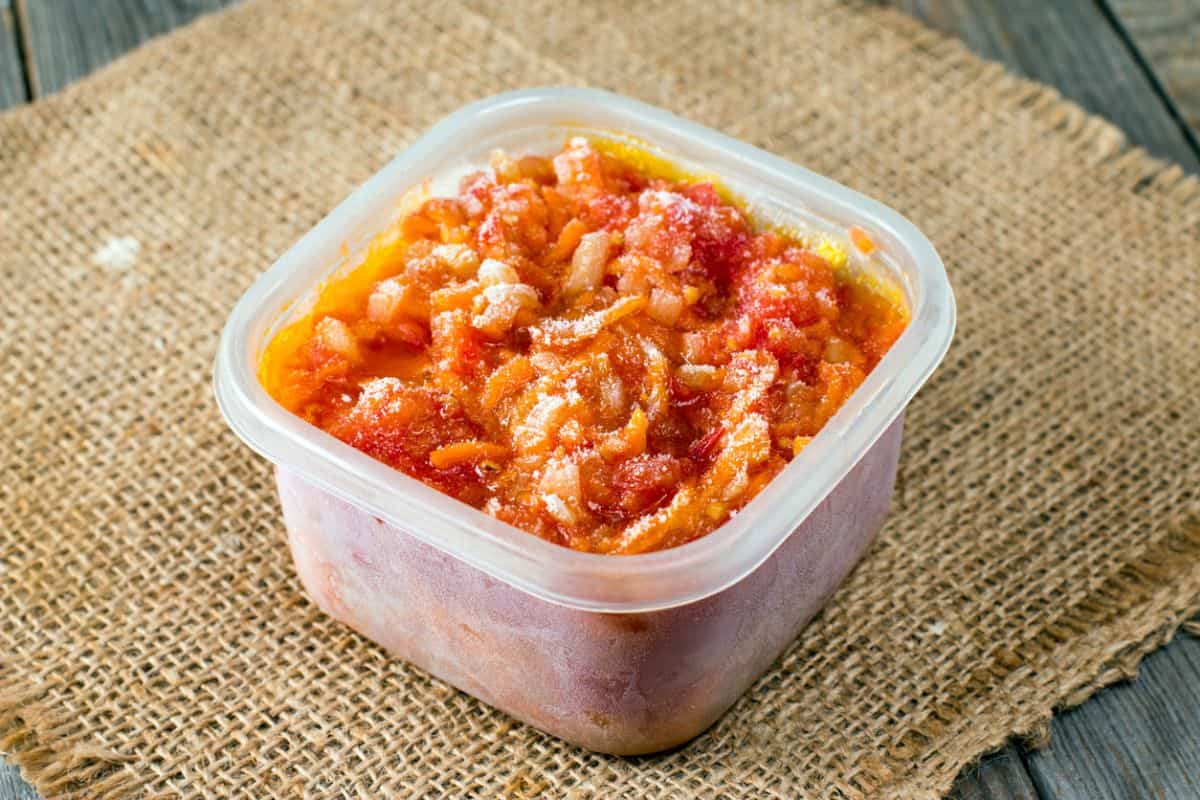You might not have considered freezing tomatoes, but you actually can. Knowing how to freeze tomatoes properly is important. Any type of tomato can be frozen, but they all have to be at their peak freshness to yield the best results.
Don’t wait until your tomatoes go soft or soggy before freezing them. If you want perfect tomatoes after defrosting, you’ll have to preserve them while they are perfect.

Types of Tomatoes to Freeze
You might consider a smaller, firmer tomato if you’d like to freeze them whole, but larger, naturally softer tomatoes do well when cutting or slicing them up before freezing.
Types of Tomatoes that Freeze Well
- Roma Tomatoes
- Cherry Tomatoes
- Plum Tomatoes
- Green or Red Beefsteak Tomatoes
- Globe Tomatoes
- Cherokee Purple Tomatoes
How to Prepare Tomatoes for Freezing

You now know you are able to freeze tomatoes, but you may be wondering what else would you need to do to freeze tomatoes properly. You don’t have to break a sweat preparing your tomatoes, but you do have to take a few steps to get the best results.
Instructions
You don’t have to peel your tomatoes before freezing. The tomato skins actually help to avoid freezer burn, plus, they will slip right off when you defrost them and run them under warm water for about 10 seconds.
Wash your tomatoes before freezing. Run them under some water first, and ensure they are nice and clean before moving on to the next step.
Core your tomatoes. Use a sharp knife to gently remove the stem of the tomato, you don’t have to get the seeds out, just the bitter core.
Flash freeze them first. If you aren’t cutting up your tomatoes, flash freeze them on a rimmed baking sheet first to avoid them from sticking to each other.
Once they are somewhat firmly frozen, transfer them to your desired containers to freeze fully.
The Best Way to Freeze Fresh Tomatoes

Freezing fresh tomatoes will always yield softer tomatoes after freezing, but that’s where the bad news end. Freezing your fresh tomatoes will prevent a lot of food waste and save you some money too.
There are different ways of freezing tomatoes, but this is the best way of doing it.
If you are planning on using the tomatoes directly from the freezer, we recommend you blanch them first, Doing so is especially recommended if you are planning to use them in a recipe that calls for canned diced tomatoes.
Otherwise, the skins will slip off the tomatoes once they have fully thawed. Use them in your favorite soups, stews, and healthy recipes.
Instructions
1. Always wash and dry your tomatoes, ensuring it is free from any debris and water.
2. Blanch your tomatoes by cutting a small cross at the base of the tomato, and carefully dropping them in a pot of boiling water for 30 -45 seconds.
3. Carefully remove the tomatoes from the boiling water with a slotted spoon and place them into a bowl of ice water. Peel off the skins once the tomatoes have cooled.
4. Remove the stem and leaves from the tomatoes, and cut out the little hard part beneath the stem. No need to remove the seeds.
5. If you want to cut your tomatoes, do so now. Cut your whole tomatoes in quarters or halves. Avoid small cuts. Pat them dry with paper towels to remove excess moisture and juice.
6. Place them skin side down on a baking sheet and cover with plastic wrap.
7. Freeze tomatoes for a few hours until they are firm.
8. Once firm, transfer to a plastic freezer bag or straight-sided mason jars. Place them in a single layer for optimal space use.
9. Vacuum seal the plastic freezer bag, either with a machine or with the straw method.
10. If using a straw, seal the plastic bag almost all the way, open a hole large enough to place a straw inside the bag. Suck out all the air. Seal the bag.
11. Freeze the tomatoes. If you are concerned about the seal on your bag, double bag your tomatoes before freezing for 9 months up to a year.
How to Freeze Tomatoes – No Blanching

Knowing how to freeze tomatoes without blanching is a great time-saving skill. Their skins will simply slip off once they thaw, so skip the blanching.
Preserving tomatoes by freezing them, will allow you to have enough tomatoes for up to 3 years. No need to wait for tomato season anymore, you can now eat tomatoes all year-round.
Frozen whole tomatoes with their skins on will prevent any freezer burn and keep them fresh-tasting when you cook with them in stews, soups, and stews.
Use plastic freezer bags if you decide to cut them up.
Instructions
1. Wash and dry your tomatoes.
2. Remove the stems and cores.
3. Cut up your tomatoes if you wish, and pat dry from any juice.
4. Place them on a baking sheet skin side down, cover with plastic wrap and freeze for a few hours in an upright freezer.
5. Vacuum seal your tomatoes with the straw method or using a vacuum sealer. The straw method requires a straw, a zip lock freezer bag, and your lungs.
6. Place your whole tomatoes in the plastic bag and seal the bag around the straw. suck out as much air as possible and quickly seal the bag. If you are using a vacuum sealer, double sealing the bag is always a great idea.
7. Place back into the freezer and use within 3 years if you have vacuum sealed them. You can skip the vacuum seal step, but you will have to use them within 9 months and have used proper freezer containers for the best results.
How to Freeze Whole Tomatoes

Freezing whole tomatoes with or without the skins on is very easy. Always choose ripe tomatoes that are still firm for the best results.
Remember that once they are thawed, the skin will slip right off if you choose not to blanch them.
Frozen whole tomatoes are easily used as replacements in recipes that call for canned whole tomatoes. Use this simple method to save you time when trying new recipes.
Instructions
1. Wash and pat your tomatoes dry.
2. Remove the stem and core.
3. Blanch your tomatoes if you wish, else leave the skin on.
4. Place your tomatoes on a baking sheet and cover them with plastic wrap. Freeze them for a few hours until firm.
5. Transfer them to a freezer container, making sure to only freeze a few tomatoes at a time to avoid having defrosted too many tomatoes at once.
How to Freeze Tomato Sauce

If you made your own tomato sauce in your instant pot, or have leftovers from your store-bought can, you can easily freeze that too to eat again later.
Transfer your tomato sauce to a clean freezer container and ensure you leave headspace if you are using a hard container, or vacuum seal your freezer bag if you are using those instead.
Remember to label your tomato sauce with the date you are freezing it, and use it within 4 months.
How to Freeze Stewed Tomatoes
You can freeze stewed tomatoes easily by transferring the cooled stewed tomatoes to a freezer container and storing them upright in an upright freezer.
If you are using a plastic freezer bag, try vacuum sealing it first to prevent as much air in the bag as possible.
Best Containers for Freezing Tomatoes
Make sure your containers are freezer proof before placing your tomatoes in them. Plastic containers that are not freezer-proof might crack, and plastic bags that aren’t meant for freezing might like or explode.
Use a reusable freezer container or ziplock bag to save money and be more eco-friendly.
Remember to leave ample headspace in your containers if you are using a hard container, about 1 inch should be enough, thus use a big enough container.
Containers for Freezing Tomatoes
- Straight-sided mason jars
- Freezer safe airlock plastic containers
- a ziplock bag that is freezer safe
Tips for Freezing Tomatoes

Whether you are freezing stewed tomatoes or tomato sauce, make sure to keep these tips handy next time you want to preserve your tomatoes in the freezer.
- Try to place your fresh tomatoes in a single layer to save some freezer space and make stacking easier.
- Upright freezers are best if you have a lot of different frozen foods, as the different foods are easier to spot in a full freezer.
- Labeled freezing bags make life easier to identify when and what you have frozen. You can even print ingredients you’ve used onto the bags.
- Diced tomatoes or stewed tomatoes are best frozen in vacuum-sealed bags since they have more surface area exposed.
- Only freeze a few tomatoes in one container to avoid having to refreeze them if you have frozen too much at once.
- Remove the stems of the tomatoes before freezing, this is the part that connects the tomato fruits to the tomato plants. It is bitter tasting, so removing it before freezing, is better than after defrosting your frozen tomatoes.
Rules for Freezing Tomatoes
1. Always wash your tomatoes and ensure they are properly dried from water.
2. Frozen tomatoes expand in the freezer. Ensure there is enough headspace in your container before placing the tomatoes in your freezer as the water content in the tomatoes will cause them to swell, and possibly explode out of your container. 1 inch is usually enough, leave more if you aren’t sure.
3. Vacuum sealing plastic bags is always recommended to avoid burns and explosions.
4. Never freeze processed store-bought tomatoes in their original packaging, especially cans. Always transfer them to clean freezer containers.
5. Ensure the containers you are planning to use to freeze your tomatoes, are freezer-safe. Freezer bags are always clearly marked in stores, use them to avoid leaks or explosions. Jar lids should be checked regularly for any damage to the seals.
6. Use labeled freezer bags when freezing tomatoes that are stewed or with tomato paste, you will be surprised how similar they might look to other dishes or sauces. Always write the date on the bag when you froze it, to prevent using old frozen tomatoes in your recipes.
7. Do not let your tomatoes ripen too much, overripe frozen tomatoes will not be good in any dish. Underripe frozen tomatoes will not be a great idea to use in recipes, either.
FAQ
Can You Freeze Cherry Tomatoes
Yes, you can freeze fresh cherry tomatoes. Freezing whole cherry tomatoes are easier, as cutting them up first might be labor-intensive. Use them in recipes that call for canned tomatoes for best results.
Can You Freeze Tomatoes Without Blanching Them First?
Absolutely. Different from stewing or canning tomatoes, you can freeze fresh tomatoes with their skins on.
If you want to remove the skins after they thaw, they are easily removed by running them under some warm water for a few seconds.
Can I use Tomatoes While Frozen?
Frozen tomatoes work great in place of canned tomatoes in most recipes for soups, stews, and sauces. Cook with them frozen if you don’t want to wait for them to thaw.
Blanched frozen tomatoes work best if you decide to cook them whilst frozen. You can even freeze your ripe tomatoes from your backyard garden or grocery store before defrosting them to process them into canned tomatoes later. It may just call for some more prep time.
How to Use Frozen Tomatoes
- Use frozen tomatoes thawed or frozen in soups, stews, and sauces for delicious and easy comfort food you can cook all year round.
- If you have the prep time to spare, but not hours for canning, freeze tomatoes first before canning them later.
- Use them in any recipes that require canned tomatoes, just remember they will cool your cooking down, so add a few more minutes of cooking on heat to make up for it. Else thaw them quickly by running them under some warm water for a few minutes.
How Long to Blanch Tomatoes Before Freezing
Blanching typically takes about 30-45 seconds in boiling water, and when removing them with a slotted spoon to transfer them to an ice bath, it takes a minute or two more. You don’t need any more special steps if you plan to freeze your tomatoes.
How Long Will Frozen Tomatoes Last in the Freezer?
Frozen tomatoes can last anywhere from 8 months to 3 years depending on how you have frozen them.
Freezing your tomatoes without vacuum sealing them, you can get away with up to one year in the freezer. Vacuum sealing your tomatoes before placing them in the freezer will get you up to 3 years in the freezer.
Can You Freeze Tomato Paste?
You can freeze tomato paste. Ensure you scoop or squeeze out any leftover tomato paste from its original container into a clean new container and freeze.
If you are using a plastic bag, try to remove all the excess air and vacuum seal the bag before freezing for the best results.
If you are using a hard container, try to use a container that isn’t more than double the size of the tomato paste, but still allows for a bit of headspace before freezing.
Tomato paste will last about 2 – 3 months in the freezer.
Conclusion
Freezing tomatoes is something not many of us knew we could do. While the tomatoes will be mushier after thawing, they can still be used in hundreds of recipes. Knowing how to freeze tomatoes can result in some great dishes.
Cooking with frozen tomatoes is just as easy since you can add them frozen or thawed. Avoid using them in recipes that call for fresh tomatoes where they won’t be cooked, and you will be good to go.
Leave a Reply